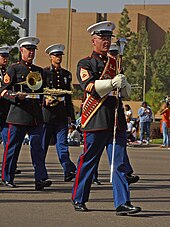Blood stripe

A blood stripe is a scarlet stripe worn down the outside leg seams of trousers on the dress uniform of the United States Marine Corps. This red stripe is 2 inches (5.1 cm) for general officers, 1+1⁄2 inches (3.8 cm) for other officers, and 1+1⁄8 inches (2.9 cm) for enlisted staff noncommissioned officers and non-commissioned officers. Modified versions are worn on the officers' evening dress uniforms, with the scarlet flanked with gold trim, and on members of the Marine Band, which wear the traditional red stripe with a white stripe in the center.
History
[edit]Trouser stripes were in use in various militaries for many years[1] (especially the British Army, whose uniforms influenced American uniforms for many years, as well as the red stripes of the Spanish Navy Marines).[2] In 1837, President Andrew Jackson ordered uniform changes that included the Marine Corps adopting the Army's practice of wearing stripes the same color as uniform jacket facings.[1] These original stripes were buff white to match changes to the uniform jacket, but when the jacket was changed back to dark blue with red trim in 1839, the stripes remained, but altered to a similar blue edged in red. A U.S. Naval Institute history of USMC uniforms records that orders issued in January 1840 provided that officers and non commissioned officers were to wear a scarlet stripe down the outside seam of their blue trousers.[3]
According to Marine Corps history, the blood stripe is to honor fallen marines from the Battle of Chapultepec in 1847, https://www.marines.com/about-the-marine-corps/who-are-the-marines/uniforms-symbols.html
- Lampasse for military trouser-stripes in general.
- Leatherneck
- Eagle, Globe, and Anchor
- Uniforms of the United States Marine Corps
U.S. Marine tradition maintains that the red stripe is worn on the trousers of the blue dress uniform, commonly known as the blood stripe, because a large number of the Marine NCOs and officers of the detachment died while storming the castle of Chapultepec in 1847, though iterations of the stripe antedate the war. Such a stripe of that time was normally reserved for officers, but due to the casualties among the officers of the battle, the NCOs lead the remainder of the assault, and hence the stripe recognizes the leadership role of NCOs thereafter. In 1849, the stripes were changed to a solid red from dark blue stripes edged in red, which dated from 1839.
References
[edit]![]() This article incorporates public domain material from websites or documents of the United States Marine Corps.
This article incorporates public domain material from websites or documents of the United States Marine Corps.
- ^ a b "Lore of the Corps". National Museum of the Marine Corps. Archived from the original on 2009-11-05.
- ^ Rankin, Robert H. (1962). Uniforms of the Sea Services. United States Naval Institute. p. 145.
Sources
[edit]- "Marine Corps Uniform Regulations". Mco P1020.34G W/Ch 1-5. United States Marine Corps. 31 March 2003. Retrieved 2008-09-05.
- Dress Blues on marines.com
- Blood Stripe on Answers.com
- "Marine Corps Uniforms". Marine For Life. 3 September 2006. Archived from the original on 23 August 2009. Retrieved 2009-10-11.
- Leicht, Paul W. (March 5, 2004). "Earning the Blood Stripe: Marines remember a legacy of sacrifice". Marine Corps Air Station Miramar: United States Marine Corps. Archived from the original on June 4, 2011. Retrieved 2009-10-11.

